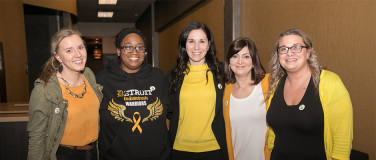
The most common question I received from women with endo on Patient’s Day on March 10 was, “What’s the best exercise for me?” (Check out my presentation “I’m in Pain. Can Exercise Help Me?”). Attendees shared with me their success and failure stories of attempting to exercise before and after surgery. Most said they had tried group exercise classes, weights, spinning, yoga and running, but they eventually stopped due to pain.
So, how do you choose the right exercise program so that you can set yourself up for success rather than failure?
As a physical therapist, I am used to people asking, “What’s the best exercise for me?” My clients are men and women, fit and sedentary, young and old, and with an assortment of injuries and varied degrees of pain. Most of them have usually asked their friends, family members, doctors, or other healthcare providers this question long before meeting me. And with the best intentions, the answers they often receive are, “You should walk on the treadmill,” “You should join a gym,” “Try lifting weights,” “Take a swimming class,” or “Start running.” The problem with these responses is that they don’t truly connect with you or the situation you are in.
Early in my career I couldn’t wait to rattle off lists of exercises and routines that I felt would improve my clients’ pain and injuries, but I noticed a strong common theme from them: “I hate to run,” “I’ve never done yoga before,” “I don’t know how to lift weights,” “I don’t have access to a gym or pool,” “I don’t feel comfortable going to a gym,” or “My work (or family) schedule is too hectic to commit to an exercise program.”
So, the answer to your question of “What’s the best exercise for me?” should be followed with another question: “What is your goal?”
Every person has a different goal. Some common goals clients first talk about are: “I want to be stronger,” “I want to be more fit,” “I want to get rid of my pain,” “I want to lose weight,” “I want to return to my favorite exercise routine,” or “I want to feel like me again!” This is a wonderful start, but I encourage clients to be more specific. For example, “What do you want to be able to do if you are stronger, fitter, healthier, or in less pain?” Responses might be, “I want to have less pain so I can go back to work,” “I want to be stronger so I can walk up my driveway and stairs again,” or “I want to have more energy so I can cook for my family.” The more specific you can be with your goals, the better you can plan your exercise program.
Next, you must identify what exercises or physical activities you like to do. Again, as an expert on exercise, I can rattle off lists of exercises that would make your head spin. Healthcare providers, friends, and family will tell you what they think you should be doing. But if you have no interest whatsoever in the exercises or activities suggested to you, then I can guarantee you will not do them. So, then, what’s the point?
I recommend that you think about activities you truly enjoy. If you are a fan of socializing and being around others, check out a gym’s group exercise or yoga class schedule. If you’re yearning for some quiet time, try a meditation podcast to practice your deep breathing. If you enjoy some fresh air, get outdoors for a walk, hike, or bicycle ride. If you used to enjoy the toning feeling you got after lifting weights, try some squats, planks, or grab some water bottles for arm curls. If it’s just been way too long due to pain and injury since you were able to participate in your fun activities, partner with a physical therapist who can show you how to get rolling safely again.
Here are a few conversations I had at Patient’s Day with women who had stopped being active due to endo pain and asked me, “What’s the best exercise for me?”
Mary had a hysterectomy earlier this month. To improve her recovery, weight gain, and energy, she was advised by a physician to walk on her treadmill every day for 30 minutes. Mary told me, “I don’t usually walk more than 10 minutes due to pain, and I hate walking on a treadmill because it is so boring!” I asked Mary, “What are your goals? What activities make you happy?” She stated that she loved her two dogs, and she missed being able to walk them. She had sadly relied on others to walk her dogs due to pain. Based on her goals and activity preferences, we agreed that walking her dogs daily would allow her to get her walking in, be outside, socialize with other dog owners and neighbors, and spend time with her beloved dogs. Mary will walk her dogs for 15 minutes, then increase her time slowly as her fitness improves. Great success!
Friends and healthcare providers recommended to Diane that she start yoga to help alleviate her endo pain. Unfortunately, she found herself in more severe pain afterwards. To her credit, she did not stop and sought other enjoyable exercises to further her goals of improved endo pain and fitness. Diane found CrossFit’s H.I.I.T (high intensity interval training) to be very beneficial to improving her strength, fitness, and pain. She described how she started a CrossFit beginners’ classes a few months ago and is now gradually moving toward advanced classes. Awesome!
Jessica was advised by co-workers that lifting weights or taking a spin class would help her lose weight after endo surgery, but Jessica felt awkward and self-conscious at the gym. There were too many machines, and Jessica did not know how to exercise. Jessica decided to try yoga because the classes focused on balance, gentle strength and stretching, and deep breathing. Now Jessica attends yoga regularly. Wonderful!
Three women with endometriosis pain, three different goals, and three different activity interests.
To answer the question, “What’s the best exercise for me?” you must ask yourself, “What are my goals?” and “What activities do I like to do?” Answering those questions will help you naturally find the answer for the correct exercise program. And if you do find that the yoga class, group exercise, weight training, jogging, or CrossFit program is too intense and causes more pain, please consult a physical therapist who is willing to partner with you so that you can successfully achieve your goals.
I look forward to writing for you again next month on more topics, including good versus bad pain, controlling your “controllables,” and exercise specifics. I welcome your feedback and ideas for future articles.
Yours in better health,
Dr. Jim Palmer, PT, DPT, CMP, COMT Founder Palmer Concierge Physical Therapy New York, NY Palmerconciergept.com Jim@PalmerConciergePT.com O: 212-289-1586









